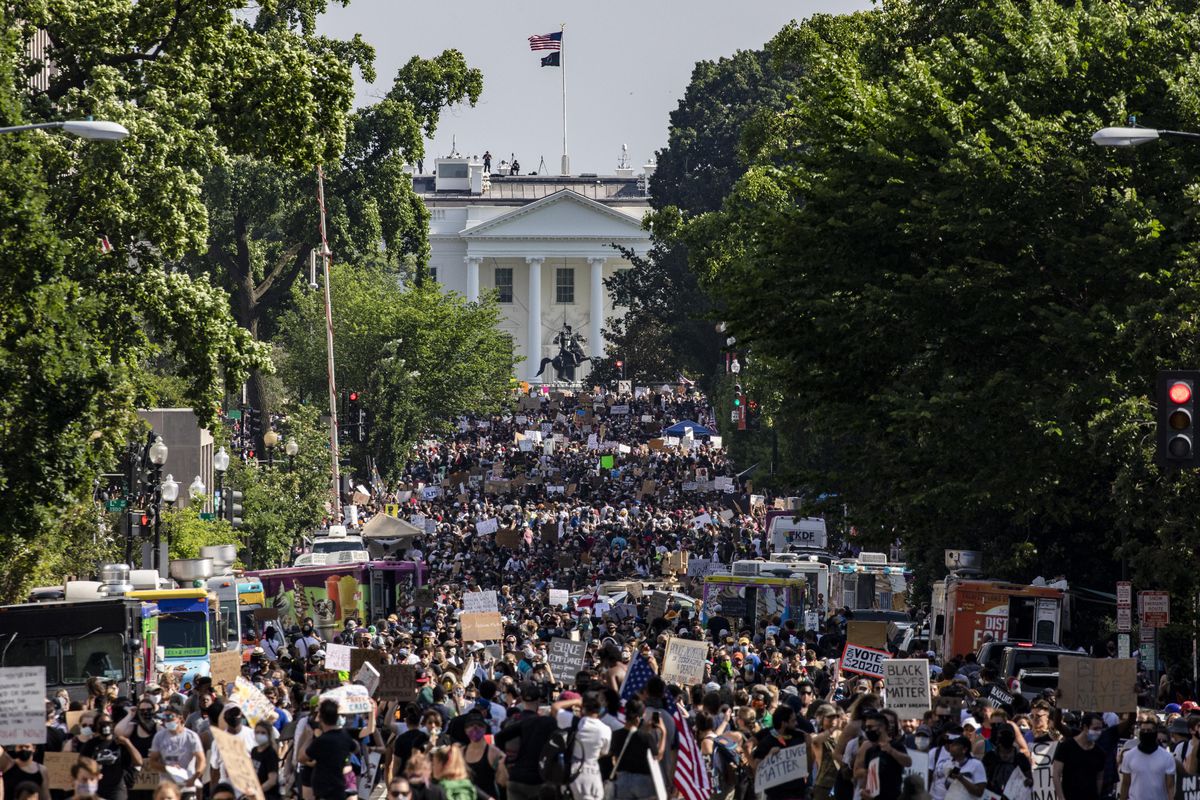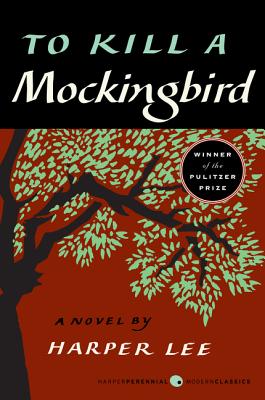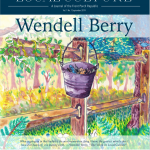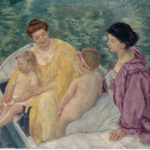Cheverly, MD. When 14-year-old Claire brought home her schoolbooks to finish eighth grade at the kitchen table last spring, To Kill a Mockingbird sat atop the stack. I’d never read it and asked if I might read it to her. To my surprise, Claire agreed. So each morning during last spring’s lockdown, in our PJs on sofas with steaming mugs, my daughter and I ventured together into 1930s Maycomb County, Alabama.
We couldn’t know when we began to read what 2020 held for us collectively as America reckoned yet again with racial injustice. I just enjoyed slipping each morning through the escape hatch that the novel held out to us. As the pandemic-stricken world around us unraveled, the novel was like a window thrown open in a cell, summoning sunlight and fresh air. It beckoned us to take a long look at a place and time distant from our own. Also, as it turned out, much closer than we knew.
Dare I admit I loved Harper Lee’s novel? Its white centering and absence of any truly developed Black characters are obvious shortcomings. Yet it contains so much beauty edged with danger, innocence entwined with experience, ominous evil assuming different faces: a lynch mob, but also a ladies’ missionary society. The interplay between Atticus and Scout, so vital to the novel’s success, offers an important life lesson as well.
Sixty years after the novel’s publication, Atticus Finch still inspires. I know two dogs and one young child named after him. Atticus is the moral exemplar par excellence, courageously fighting injustice in the courts and treating all in his purview—black, white, rich, poor—with respect. In his insistence on human dignity, on empathy, he proves a powerful unifying force in his community. “If you can learn a simple trick, Scout,” he tells his daughter, “you’ll get along a lot better with all kinds of folks. You never really understand a person until you consider things from his point of view, . . . until you climb into his skin and walk around in it.” In our own fractured society, we could use more heroes like Atticus.
Yet for all his appeal, Atticus would be nothing without Scout. It’s her fresh narrative voice that draws us in, even as it strikingly lays bare hypocrisy and pretension. Through Scout the reader experiences the novel’s central crisis—the wrongful conviction of an innocent Black man—with all the confusion and hope, devastation and anger of a child recognizing injustice for the first time.
When she can’t grasp why her aunt won’t let her play with a boy who lives in the woods (“Because—he—is—trash, that’s why!”), her brother Jem shrewdly explains the local pecking order, with “ordinary” white folks at the top and Negroes at the bottom. Scout’s response is startling: “Naw, Jem, I think there’s just one kind of folks. Folks.” Jem’s four-tiered taxonomy may be true-to-life in 1930s Maycomb County, truer to our own experience than we’d care to admit. Yet Scout’s simple statement of equality is heroic in its own right.
Children are artless, to use an old-fashioned term, which by definition denotes a default setting: unfeigned innocence, uncultivated sincerity. It is simply how they are, and why Jesus likened the greatest in God’s Kingdom to “one of these little ones.” It’s what makes Scout such an effective narrator: she hasn’t yet been socialized into the racism or classism of her milieu. Through life experience, reflective adults may cultivate wisdom—a nuanced understanding of how to live well in a complex world. But such wisdom relies at times for calibration on the stark clarity, the brutal honesty, of the child’s vision.
As a parent of three school-age children I can’t help but read To Kill a Mockingbird as a novel of moral formation. Scout’s perception is what it is—ingenuous, incisive, generous— because of Atticus’s influence. However detached his parenting style may be by our standards (he doesn’t even attend her school play!), he has successfully imparted to Scout a moral framework by which to live. Yet the reverse is just as true: Atticus would not be the man he is without Scout. She’s internalized his ideals and now, in his moments of weakness, she calls him back to his own values. She becomes his plumb line.
In the novel’s denouement, Atticus only slowly perceives the evening’s events as they happened: it was the reclusive Boo Radley, not young Jem, who killed Scout’s assailant Bob Ewell. It’s difficult for Atticus to grasp the implications of this fact and his obligations as a lawyer, citizen, and neighbor. But Scout implicitly sees past the blunt, blind distinctions of the Law to the beating heart of sin and redemption. In a lovely adaptation of Atticus’s earlier imagery, she confirms that drawing attention to Boo’s heroic act would devastate their fragile neighbor. “It’d be sort of like shootin’ a mockingbird, wouldn’t it?”
This is the humbling gift our children offer. If we seek to shape their character, at some point in the journey we’ll find ourselves backed into a corner, faced with our own hypocrisy. We’ll never perfectly embody the ideals we preach. And while we may conceal the gap between rhetoric and action from most, we can’t hide it from our children. But we can listen when they call us out. We can heed their honest judgments of our faults, no matter how ill-timed, unbidden, or even impertinent.
We may indeed be shaping their character. They are likewise shaping ours.
I was raised in a white liberal college town in the Pacific Northwest. Diversity and tolerance were virtues oft-celebrated but seldom tested. My congenitally conservative family did not fit in. We esteemed ancient and European history, etiquette and tradition, liturgy and hymnody. We cherished the Western classics—no matter that the canon featured mostly dead white men.
Burrowed in our white liberal enclave (wishing it weren’t quite so liberal), geographically remote from regions where racial tensions ran high, I enjoyed the luxury of ignorance. Even when I went to college in the South, I remained ensconced in my white friend group, ignorant and indifferent to the ways racism still held us in its grip. At home one summer I dated a Black man, an unremarkable event in the Northwest. When I let this fact slip to some Southern friends back at college, I was unprepared for their shock and horror. I hadn’t realized such prejudice still lurked in corners of my experience.
Mine was one form of naivete, of “artlessness.” I might have awoken then. My indignation might have provoked a new attentiveness to the experience of African Americans on my campus, or behind the cash register at Food Lion. But my summer romance had ended. I’d moved on. I was blinded by my conservative ideology, my middle-class insularity, my quixotic love of Victorian England. It would take me decades to understand—to the extent that I do—white supremacy’s insidious and far-reaching effects on our society. On my own thoughts and perceptions and actions.
My daughter has been one catalyst for seeing.
Whites are a minority in the county where we live just outside of Washington, D.C. For a time last year, Claire said she was the only “white kid” in her group of school friends. She might not know much about the Civil Rights Movement. But even in a setting as diverse as ours, she recognizes ways in which white people are given more grace and allowances than people of color. Last year, long before we read Lee’s novel, she read Just Mercy and watched The Hate You Give on her own. I scrambled to catch up. One afternoon last winter, distraught after overhearing a racially charged comment from a teacher, she emailed the principal. I helped her write a note that appropriately expressed her concern, and felt my own conscience pricked—by the simple fact that she cared.
Full disclosure: our mother-daughter read-aloud meant more to me than it did to Claire. I’d envisioned wrestling together with the book’s themes of racial injustice and communal obligation, the power of empathy and righteous indignation. Claire viewed it as a task to be completed. Her teacher’s assignment—to reduce each chapter’s events to three terse phrases consisting of a noun and a verb—only fueled her determined efficiency. Like so much in parenting, ideal yields to reality. Family dinners devolve into squabbles. Expensive vacations are marred by illness. Complex themes are reduced to simple phrases. Alexandra scolds; Scout cries; Atticus explains.
I’ve heard parenting described as a long, interrupted conversation, meaning that if we don’t settle a topic tonight, we’ll return to it next week or even next year. This proved true in our reading. Real life required it.
We finished the novel in May, around the night of George Floyd’s murder. The timing was poignant. The eight-minute, forty-six-second video on our screens served as a heart-wrenching analogue to the events of the novel. The fury that broke out across the nation was an echo of Jem’s anguish at the jury’s guilty verdict, one that had grown in fury and volume and reach.
“It was Jem’s turn to cry. His face was streaked with angry tears as we made our way through the cheerful crowd. ‘It ain’t right,’ he muttered, all the way to the corner of the square where we found Atticus waiting. . . . ‘It ain’t right, Atticus,’ said Jem.”
Later, when Jem asks his father, “‘How could they do it, how could they?’” Atticus replies, “‘I don’t know, but they did it. They’ve done it before and they did it tonight and they’ll do it again and when they do it—seems that only children weep.’”
The protests across America signaled a depth of lament and outrage wider-ranging than Atticus could have imagined. We watched on CNN as protestors clashed with police near the White House, just a few miles from our home. Claire asked if I would take her downtown to join them. I demurred; the protest looked unsafe. The truth was I’m a news-watcher, a novel-reader, not a demonstrator. Yet as the days passed I considered her request. My teenage daughter’s convictions are instinctual, and more passionate than my own. She wants to make her voice heard.
When I learned of a demonstration organized by Washington D.C. pastors a few days later, I took Claire and her younger sister. Friends joined us. We met east of the Anacostia River and marched across a bridge to Capitol Hill. Streams of protestors who’d marched from elsewhere in the District converged so that, like a powerful stream, we moved a thousand strong toward the Capitol. I kept seeing people I knew, Black and White, old and young, families with small children who’d decided—despite the inconvenience—they wanted even their littlest to participate. We all wore masks and resisted the urge to hug. At the reflecting pool in front of the Capitol, pastors spoke and prayed.
At one point, I got separated from my daughters. Atop the bridge, looking back over a sea of marchers holding signs with slogans like Love Mercy and Black Lives Do Matter – Gen. 1:27, I made out their faces through the crowd. There was Claire, walking alongside her friend, half-oblivious to the import of what she was doing. Nothing in the moment—crossing a bridge with hundreds of marchers for racial justice singing “Amazing Grace,” the dome of the U.S. Capitol before us on the horizon—evoked for her images from America’s past, as it did for me. She was just enjoying the energy of the crowd and, after the long COVID lockdown, conversation with her friend. Yet perhaps her experience that Sunday would accumulate meaning and association as she grew and lived and learned.
A Washington Post reporter asked me why I’d come. “My teenage daughter wanted to march for racial justice,” I told her. “Her concern is prompting me to care.”
My own Scout, with her pure conscience that pricked my jaded one, helped me on this journey.









7 comments
Phillip Dennis
Keep up the reading with your kids! About a month into the COVID-19 shutdown, we realized we were watching too much TV, so we turned it off and started reading aloud together as a family every night after dinner. We were already in the habit of starting the day with a chapter or two from the Bible and a hymn in the morning. Reading at night made a nice way to slow down and regroup as a family at the conclusion of the day.
We’ve read all kinds of books over the last year, most of it slightly above their level: The Adventures of Tom Sawyer, The Strange Case of Dr. Jekyll and Mr. Hyde, Tarzan of the Apes (so much better than I would ever have imagined), Rifles for Watie, A Walk in the Woods (had to censor a few paragraphs from that one), and biographies of George Washington Carver and Michael Faraday. Tonight we expect to finish Corrie Ten Boom’s “The Hiding Place,” which is challenging but has prompted some important discussions and has helped to open their eyes to important truths about human nature, sin, and grace.
It’s not always easy because young kids get distracted or create distractions. My kids are 4, 6, and 10, so there are usually a few interruptions during any given reading. I’ve learned more about patience, and they’ve learned very well to sit still and pay attention. Finally, about a month ago–and at my children’s urging, since it was never being used anyway–we got rid of the TV altogether.
leroy See
I can’t help saying that I am afraid to say what I want to say. Hemingway’s poetry paraphrased by me suggested that our age demands that we dance…but only in iron pants, has come to America. Civil discussion about “race” is impossible lest a teacher or professor or parent be accused in the now monolithic public square of “wrong think” needing correction and silencing. Harper Lee’s other work deserves reading also but has been vilified and cancelled as “unwoke” and deserving to be tossed into the fire of the altar of correctness. Woe be it to a teacher or professor who would choose to use it to frame a civil discussion about race in America and perhaps the world over including Africa, Asia, and Europe.
Over the years academia had become the champion of wrong think for reasons I don’t understand. In the 1970’s the right to free speech was fought for in the streets and on campuses. In 2021 he right to free speech is fought against by the heirs of having gained it only to now suppress or “cancel” dissenting opinions.
As a nation the lack of civil discourse about “race” and many other aspects of modern life is a symptom of a culture gone wrong. The fear of retribution for “wrong think” can only have dire consequences if thinking itself is its logical consequence. I myself don’t believe there is “an answer” to whatever “race” is except to be able to discuss race and racist and racism as global in nature.
I hope that all of Harper Lee’s work survives the current cancellation of it and other works. I also hope that academic silence of such discussion is not that of the lambs much longer.
Beverly
Out of the mouth of babes.
Brian
TKAM has apparently been removed from the curriculum in many places in recent years because it’s verboten to suggest that sexual assault allegations may not always be true (except for those against Democrat politicians, of course).
“One afternoon last winter, distraught after overhearing a racially charged comment from a teacher, she emailed the principal.”
Chilling. I know a teacher who a few years ago said to another teacher “Interesting mix of kids we have this year” which was misheard by students (or twisted) and reported to the principal as having referred to them as “a bunch of Mexicans.” Thankfully it was before social media really took off, and the other teacher was able to vouch for the truth.
I note you say “racially charged”, not “racist”, which is a huge red flag, but even conceding that what was heard was accurate and complete, teaching your daughter that it is acceptable, even commendable, to denounce her teacher is only a half-step away from her believing it is acceptable to denounce you.
Russell Arben Fox
Interesting comment, Brian. Something has “apparently” been done in “many” places in “recent” years. An undisputable argument, that is.
Russell Arben Fox
A beautiful, thoughtful essay, Heather. As a parent of only daughters–all of whom as they have grown have obliged me to think hard about and learn more about issues which are presented to me as intellectual problems, but which they encounter as simple lived experience–I strongly relate to the way you describe having been guided in your own moral development by their “artlessness”; the same could very much be said for me. Thank you for sharing your writing here.
Rob G
I love TKAM, both the book and the movie, yet I can’t help thinking about the latter, and how if Hollywood or one of the networks were to attempt to remake it today, God forbid, it would most likely be an ideological disaster. While this essay doesn’t fall into the trap, in our current culture such books as TKAM are very often not allowed to speak for themselves, but instead are forced through the filter of wokeness. In fact, I would not at all be surprised if down the line Lee’s book and the film thereof come under attack by the wielders of that filter.
Comments are closed.